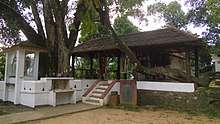Pattini
Pattini (Sinhala: පත්තිනි දෙවියෝ, lit. 'Pattiṉi Deviyō', Tamil: கண்ணகி அம்மன், lit. 'Kaṇṇaki Am'man'), is considered a guardian deity of Sri Lanka in Sri Lankan Buddhism and Sinhalese folklore. She is also worshipped by Sri Lankan Tamil Hindus by the name of Kannaki Amman. She is considered the patron goddess of fertility and health, particularly protection against smallpox, which is referred to as deviyange ledé ('the divine affliction') in the Sinhala language.
| Pattini | |
|---|---|
| Other names | Pattini Deviyo |
| Affiliation | Kannaki Amman |
| Symbol | Anklet, Neem leaves |
| Mount | Pigeon |
History
Goddess Pattini is the deification of Kannagi, who is the central character of the Tamil epic Silapadhikaram of Ilango Adigal, written in India after the 2nd Century CE. After a short time, it was introduced into Sri Lanka and absorbed earlier deities such as Kiri Amma ('milk mother'). Historians attribute the introduction of goddess Pattini to the island to Gajabahu I, a Sinhalese king who ruled Sri Lanka from 113 - 135 CE. As per some historians, the Silapathikaram mentions Gajabahu's presence at the consecration of a temple to Kannagi (identified as Pattini in this case) by the Chera king Senguttuvan.
Rituals
Pattini is honoured in annually fertility rites such as
- Gammaduwa (village rebirth) festivals, during which her myth is enacted.
- Ankeliya (horn games) in which, as in the British game of Uppies and Downies, upper and lower teams compete.
- Porakeliya (fight games) during which two teams hurl coconuts at each other.
Milk-mother's alms-giving
Sinhalese people believe that diseases like chickenpox and measles are punishments by God for frailty. In such events as the goddess of healing they pray to Pattini Devi. When a family member is infected, they hold Dānas (alms-givings) for her, called Kiri-amma dāna (Milk-mother's alms-giving).
Pattini temples in Sri Lanka
| Devalaya/Temple | Image | Location | District | Province | Description | Refs |
|---|---|---|---|---|---|---|
| Halpe Pattini Devalaya |  | Halpe | Badulla | Uva Province | Archaeological protected monument | [1] |
| Kabulumulla Pattini Devalaya | align=center | align=center | align=center | One of the four major Pattini temples which the great 'Pattini Salamba' exists. This devale was built by King Rajasinghe I in 1582. This is situated in Colombo-Hatton Rd. 15 km from Avissawella | ||
| Lindamulla Pattini Devalaya |  | Lindamulla | Badulla | Uva Province | Archaeological protected monument | [2] |
| Maduwa Pattini Devalaya | align=center | align=center | align=center | The festival of the Pattini Devale is held annually during July–August season. | ||
| Mahanuwara Pattini Devalaya | Kandy | Kandy | Central | Pattini Devale is located to the west of Natha Devale close to Sri Dalada Maligawa premises. | ||
| Nawagamuwa Pattini Devalaya | Nawagamuwa | Colombo | Western | As the legend unfolds King Gajabahu I of Anuradhapura (A.D. 114 - 136) came from India with 12,000 men as prisoners, bringing with him a Pattini anklet, he landed at a place close to devalaya. Devalaya was built enshrining the anklet. | [3][4] | |
See also
References
- "Ella Halpe Pattini Devalaya". Department of Archaeology. Retrieved 11 March 2018.
- "Gazette". The Gazette of the Democratic Socialist Republic of Sri Lanka. 1401. 8 July 2005.
- "Nawagamuwa Devalaya - Dedicated to goddess Pattini". Sunday Observer. 17 April 2011. Retrieved 11 March 2018.
- Nawagamuwa Pattini Devalaya (Sri Sugathabimbaramaya) Retrieved 11 March 2018.
Further reading
- Bastin, Rohan (December 2002). The Domain of Constant Excess: Plural Worship at the Munnesvaram Temples in Sri Lanka. Berghahn Books. ISBN 1-57181-252-0.
- Obeyesekera, Gananath (1984). The Cult of the Goddess Pattini. University of Chicago Press. ISBN 0-226-61602-9.